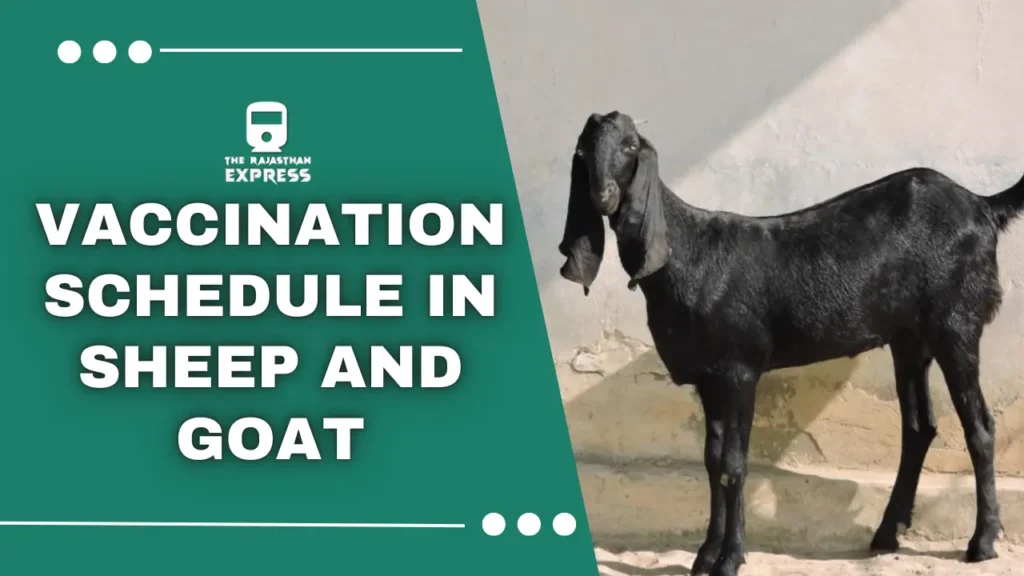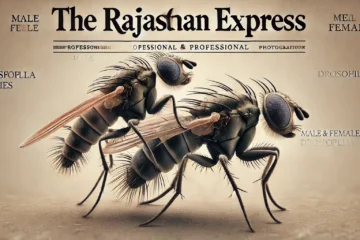Vaccination Schedule In Sheep and Goats
Today, we live in an environment surrounded by pollution, which is giving rise to new diseases every day. This impact is not only on humans but also on the plants, animals, and birds around us. Just like humans, animals and birds are also facing new diseases every day. As a result, farmers are suffering economic losses. In a developing country like India, where animal husbandry plays a crucial role in economic development, the sudden outbreak of an epidemic among animals can severely impact the country’s economy.
While the process of finding cures for new diseases is ongoing, the failure to vaccinate against existing diseases for which vaccines are available further increases the economic risks. Due to some misleading information, some farmers refrain from vaccinating their animals, which leads to economic losses for them.
Failure to vaccinate on time results in diseases spreading from one animal to another, causing an epidemic. This severely affects the local healthcare system, economic progress, and the animal population. The only way to prevent such problems is to ensure timely vaccination for diseases that have available vaccines and to raise awareness among farmers about the benefits of vaccination.
Farmers should prioritize vaccination against all types of infectious diseases. Nowadays, combined vaccines are also available that protect animals from multiple diseases with a single shot. The government runs several campaigns and schemes to promote vaccination, ensuring the protection of animals from diseases and preventing economic losses for farmers.

Vaccination in cows, buffaloes, sheep, and goats is crucial for maintaining their health and ensuring the productivity of livestock. A well-organized vaccination schedule can prevent outbreaks of infectious diseases, thus safeguarding your animals and your livelihood. In this blog post, we will provide information about the recommended vaccination schedule for sheep and goats as advised by veterinary experts. Today, we will discuss which diseases in sheep and goats are vaccinated at what age.
Vaccine: A vaccine is a substance administered to develop active immunity in the body against infectious diseases. Its primary goal is to prepare the body’s immune system so that an individual or animal can remain protected from specific diseases.
History of the Word “Vaccine”: The word “vaccine” was first coined by Edward Jenner. The first vaccine developed was the smallpox vaccine, created by Edward Jenner in 1796 from the cowpox virus. This vaccine was used to protect humans from smallpox. The term “vaccine” is derived from the word “Vaccinia Virus,” which refers to the cowpox virus.
General Science of Vaccines: Most vaccines contain antigens, which are given in an inactive form.
Precautions Before Vaccination:
- Before vaccinating, an animal’s health should be thoroughly checked.
- If the animal is suffering from any disease, vaccination should not be carried out.
- Deworming should be done before vaccination.
- Vaccination should only be administered to healthy animals.
- In most animals, vaccines are administered subcutaneously (under the skin).
- For some diseases, vaccines are also administered intramuscularly (in the muscles).
- In sheep and goats, the CCPP vaccine is the only one given via the intradermal route, i.e., in the skin.
Benefits of Timely Vaccination
- If the animal stays healthy, milk production will increase, resulting in economic benefits for the farmer.
- In poultry, egg and meat production will increase.
- There will be a lower chance of zoonotic diseases (diseases transmitted from animals to humans) for those consuming animal products.
- If vaccinations are not done on time for infectious diseases on sheep and goat farms, an outbreak could result in the death of all the sheep and goats on the farm. This is why vaccination is mandatory.
- Vaccination contributes to the economic progress of the country.
Key Vaccines for Sheep and Goats
Various bacterial and viral diseases require specific vaccines, which are administered at different stages of the animals’ life. Below is information about the key vaccines for sheep and goats:
| The Rajasthan Express: Vaccination Schedule In Sheep and Goat | |||||
| Disease | Vaccine Name | Age | Route | Dosage | Booster Dose |
|---|---|---|---|---|---|
| Black Quarter (Langda Bukhar) | Alum Precipitated BQ Vaccine | 6 Months | Subcutaneous (S/C) | 2.5 mL | Annually, before monsoon (May-June) |
| Haemorrhagic Septicaemia (Galghontu) | Alum Precipitated Vaccine | 6 Months | Subcutaneous (S/C) | 2.5 mL | Annually, before monsoon (May-June) |
| Anthrax |
Pasteur Vaccine Spore Vaccine Sterne Vaccine |
6 Months | Subcutaneous (S/C) | 2.5 mL | Annually, before monsoon (May-June) |
| Foot and Mouth Disease (FMD) | Raksha-Ovac Trivalent Vaccine | 2-3 Months (Calves) | Deep Intramuscular (I/M) | 1 mL | Twice a year, 6 months apart (September and March) |
| Enterotoxaemia (Fadkiya) | Raksha E.T Vaccine | 3 Months | Subcutaneous (S/C) | 2 mL | Annually, before monsoon (May-June) |
| Peste des Petits Ruminants (PPR) | Raksha PPR Vaccine | 3 Months | Subcutaneous (S/C) | 1 mL | Every 3 years |
| Sheep and Goat Pox | Raksha Sheep Pox Vaccine Raksha Goat Pox Vaccine |
3 Months | Subcutaneous (S/C) | 1 mL | Annually |
| Contagious Caprine Pleuropneumonia (CCPP) | CCPP Vaccine | 3 Months | Intradermal (I/D) | 0.2 mL | Annually |
| The Rajasthan Express: Vaccination Schedule In Sheep and Goat | |||||
- Hemorrhagic Septicemia
Hemorrhagic Septicemia (HS) is a severe and rapidly spreading bacterial disease. It primarily affects cattle and buffaloes, especially during the monsoon season. The mortality rate of affected animals can be as high as 80-90%.
Etiology:
The primary cause of this disease is the bacterium Pasteurella Multocida.
It is a Gram-negative bacterium.
Pasteurella Multocida is a bipolar bacterium.
Location:
This bacterium can survive in the respiratory tract of animals for an extended period.
Disease Duration and Classification:
Duration:
The disease lasts for only 2-3 days.
Classification:
It is considered an acute disease because it spreads rapidly and can quickly lead to the death of the animal.
Affected Age:
This disease is most common in animals aged between 6 months and 2 years.
Symptoms:
- High fever
- Difficulty in breathing
- Swelling and pain in the throat
- Weakness and lethargy
Vaccination:
Timely vaccination is crucial to prevent Hemorrhagic Septicemia.
Primary Vaccination:
- Age: 6 months
- Dose: 2.5 mL
- Route: Subcutaneous (S/C)
Annual Booster:
- Administered annually before the monsoon (in May-June).
- Black Quarter Disease
Black Quarter, also known as Black Quarter Disease, is a severe bacterial disease primarily affecting cattle and buffaloes. The disease is caused by gas-filled swelling in the muscles of the shoulder or thigh, leading to high fever and septicemia, which can result in the animal’s death.
Symptoms:
- Gas-filled swelling in the shoulder or thigh muscles
- High fever
- Septicemia
- Swelling and pain in the affected area
Disease Duration:
Black Quarter lasts from 2 to 6 days, making it an acute disease.
Prevalence in India:
This disease is primarily found in Karnataka, Andhra Pradesh, Tamil Nadu, and Rajasthan.
Most cases are observed in Mumbai, Hyderabad, and Mysore regions.
The disease is more common in regions with a hot and humid climate.
Disease Characteristics:
- Enzootic Disease: Black Quarter is considered an enzootic disease, affecting a large number of animals in a small area.
- Epizootic Disease: If the rate of spread increases, it can become an epizootic disease.
Etiology:
The disease is caused by the bacterium Clostridium Chauvoei, a Gram-positive bacterium.
Bacterial Characteristics:
- The bacterium forms spores that can survive in the soil for many years.
- It is anaerobic and can live without oxygen.
- The shape of the spores resembles a drumstick or tennis racket.
Method of Eradication:
- Use a 3% formalin solution.
Vaccination:
Vaccination against Black Quarter should be done before the monsoon.
Vaccine Name: Alum Precipitated BQ Vaccine
Dose: 2.5 mL
Route: Subcutaneous (S/C)
Primary Dose: At 6 months of age
Booster Dose / Revaccination: Annually before the monsoon (in May-June).
- Anthrax
Anthrax is a severe and contagious disease caused by the bacterium Bacillus anthracis. It primarily affects cattle, buffaloes, and sheep, with sheep being more commonly affected. Anthrax is a zoonotic disease, meaning it can spread from animals to humans.
Other Names:
- Spleenic Fever
- Wool Sorter’s Disease
- Hide Porter’s Disease
- Gilt Disease
- Poisonous Fever
Etiology and Spread:
Cause:
Bacillus anthracis, a Gram-positive rod-shaped bacterium.
Spread:
- Contaminated water and soil
- Flies and carnivorous birds
- Blood and discharge from infected animals
Seasonal Spread:
The disease spreads more in hot and humid weather.
Vaccination:
Vaccination against Anthrax should be carried out before the monsoon.
Vaccine Names:
- Pasteur Vaccine
- Spore Vaccine
- Sterne Vaccine
Dose: 2.5 mL
Route: Subcutaneous (S/C)
Primary Dose: At 6 months of age
Booster Dose / Revaccination: Annually before the monsoon (in May-June).
- Foot-and-Mouth Disease (FMD)
Foot-and-Mouth Disease (FMD) is a highly contagious viral infection caused by the Aphthovirus, a member of the Picornaviridae family. This disease primarily affects cloven-hoofed animals such as cows, buffaloes, goats, sheep, and pigs. It significantly reduces milk production, meat quality, and wool yield in animals, leading to considerable economic losses for livestock farmers.
Key Features:
Cause:
- Caused by the Aphthovirus.
- Picorna Virus, the smallest virus found in animals.
- In India, this disease is primarily caused by the A, O, and ASIA-1 strains.
- The C strain has been eradicated in India.
Impact of Infection:
- The disease affects cloven-hoofed animals (cows, buffaloes, goats, sheep, pigs).
- Animals with non-cloven hooves, such as horses and donkeys, are not affected.
- There is a significant reduction in milk production, meat quality, and wool yield.
FMD Vaccination: There is no effective treatment for FMD, so vaccination is the only prevention method.
Vaccine Name: Raksha-Ovac Trivalent Vaccine
Dosage: 1 mL
Administration: Deep Intramuscular (I/M)
Primary Dose:
For calves and young animals, at the age of 2-3 months.
Booster Dose / Revaccination:
Twice a year, with a 6-month interval (September and March).
Vaccination Requirement:
- Regular vaccination against FMD should be carried out in cloven-hoofed animals.
- Timely vaccination improves the productivity of animals and protects livestock farmers from economic losses.
- Enterotoxaemia
Cause: This disease is primarily caused by the Clostridium perfringens bacteria (a Gram-positive bacteria). It spreads more commonly during the monsoon season.
Vaccination Information:
Vaccine Name: Raksha E.T Vaccine
Dosage: 2 mL, Subcutaneous (S.C.)
Primary Dose: At the age of 3 months
Booster Dose / Revaccination:
- Annually, before the monsoon (in May-June).
- Goat Plague (PPR/Pseudo Rinderpest)
Cause: This disease is caused by the Morbillivirus and primarily affects the digestive system. It is common in goats.
Vaccination Information: Vaccine Name: Raksha PPR Vaccine
Dosage: 1 mL, Subcutaneous (S.C.)
Primary Dose: At the age of 3 months
Booster Dose / Revaccination:
- Every 3 years.
- Sheep Pox and Goat Pox
Cause: These diseases are caused by the Capripox Virus. They are contagious diseases that spread through direct contact with the body.
Vaccination Information:
Vaccine Names: Raksha Sheep Pox Vaccine and Raksha Goat Pox Vaccine
Dosage: 1 mL, Subcutaneous (S.C.)
Primary Dose: At the age of 3 months
Booster Dose / Revaccination:
- Annually.
- CCPP (Contagious Caprine Pleuro Pneumonia)
Cause: This disease is caused by the Mycoplasma mycoides caprae bacteria.
Vaccination Information: Vaccine Name: CCPP Vaccine
Dosage: 0.2 mL, Intradermal (I.D.)
Primary Dose: At the age of 3 months
Booster Dose / Revaccination:
- Annually.
Learn about the essential vaccination schedule for sheep and goats to ensure their health and protection. Our comprehensive guide covers vaccines, timing, and tips for livestock care.
THE RAJASTHAN EXPRESS
People Also Ask
What is PPR disease in goats?
What vaccines are available for sheep and goats?
Against which diseases are goats vaccinated?
Against which diseases are sheep vaccinated?
When is the PPR vaccine administered to goats?
Vaccination Details:
- Vaccine Name: Raksha PPR Vaccine
- Dosage: 1 mL (Subcutaneous – S/C)
- Primary Dose: At 3 months of age
- Booster Dose: Once every 3 years
When is the Enterotoxemia (ET) vaccine administered to goats?
When is the Hemorrhagic Septicemia vaccine administered to goats?
When is the Anthrax vaccine administered to goats?
When is the Goat Pox vaccine administered to goats?
When is the Enterotoxemia vaccine administered to goats?
Vaccination Details:
- Vaccine Name: Raksha ET Vaccine
- Dosage: 2 mL (Subcutaneous – S/C)
- Primary Dose: At 3 months of age
- Booster Dose: Annually, before the monsoon (May-June)
What is the dosage for PPR vaccination in goats?
Vaccination Details:
- Vaccine Name: Raksha PPR Vaccine
- Dosage: 1 mL (Subcutaneous – S/C)
- Primary Dose: At 3 months of age
- Booster Dose: Once every 3 years



